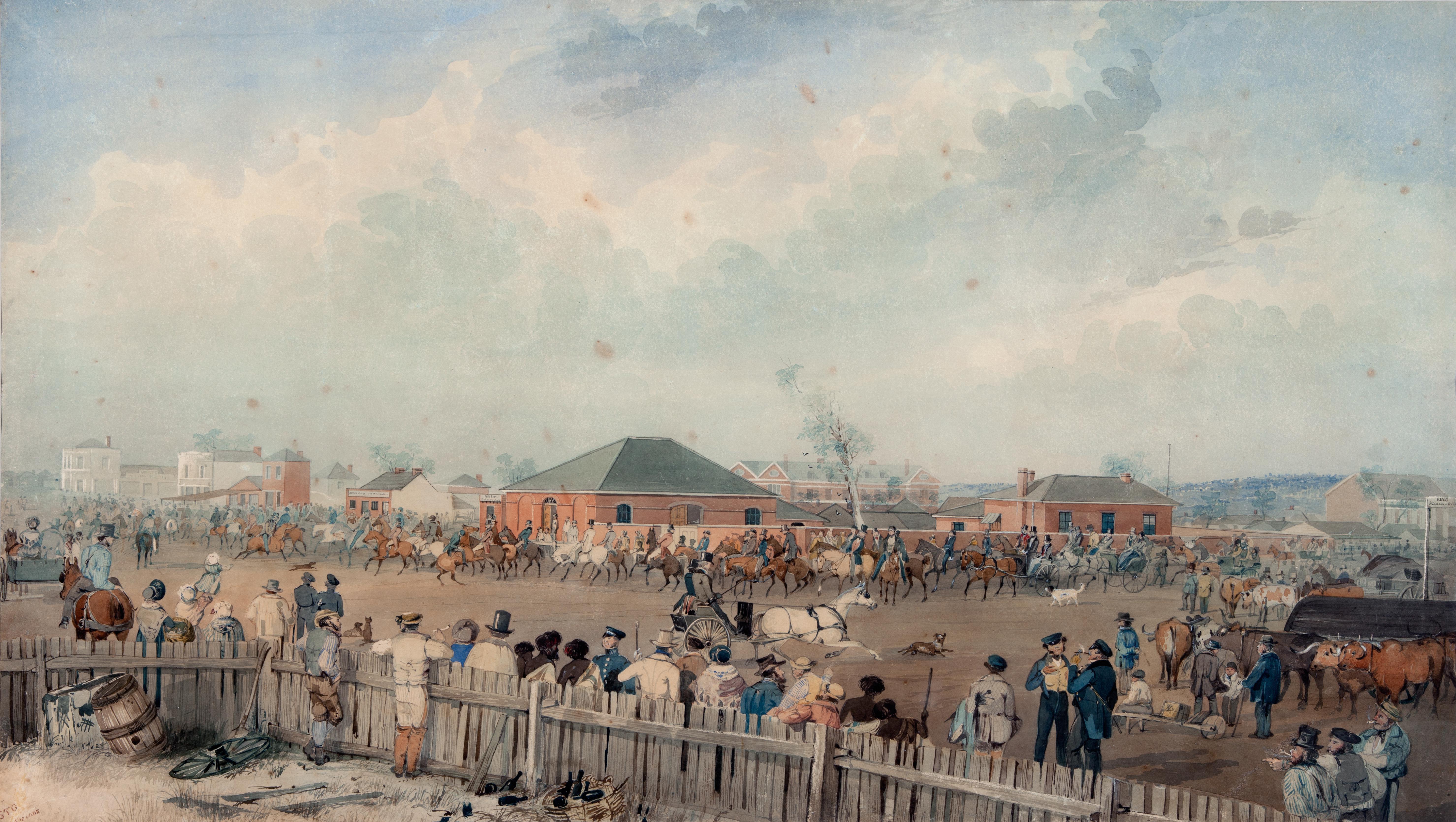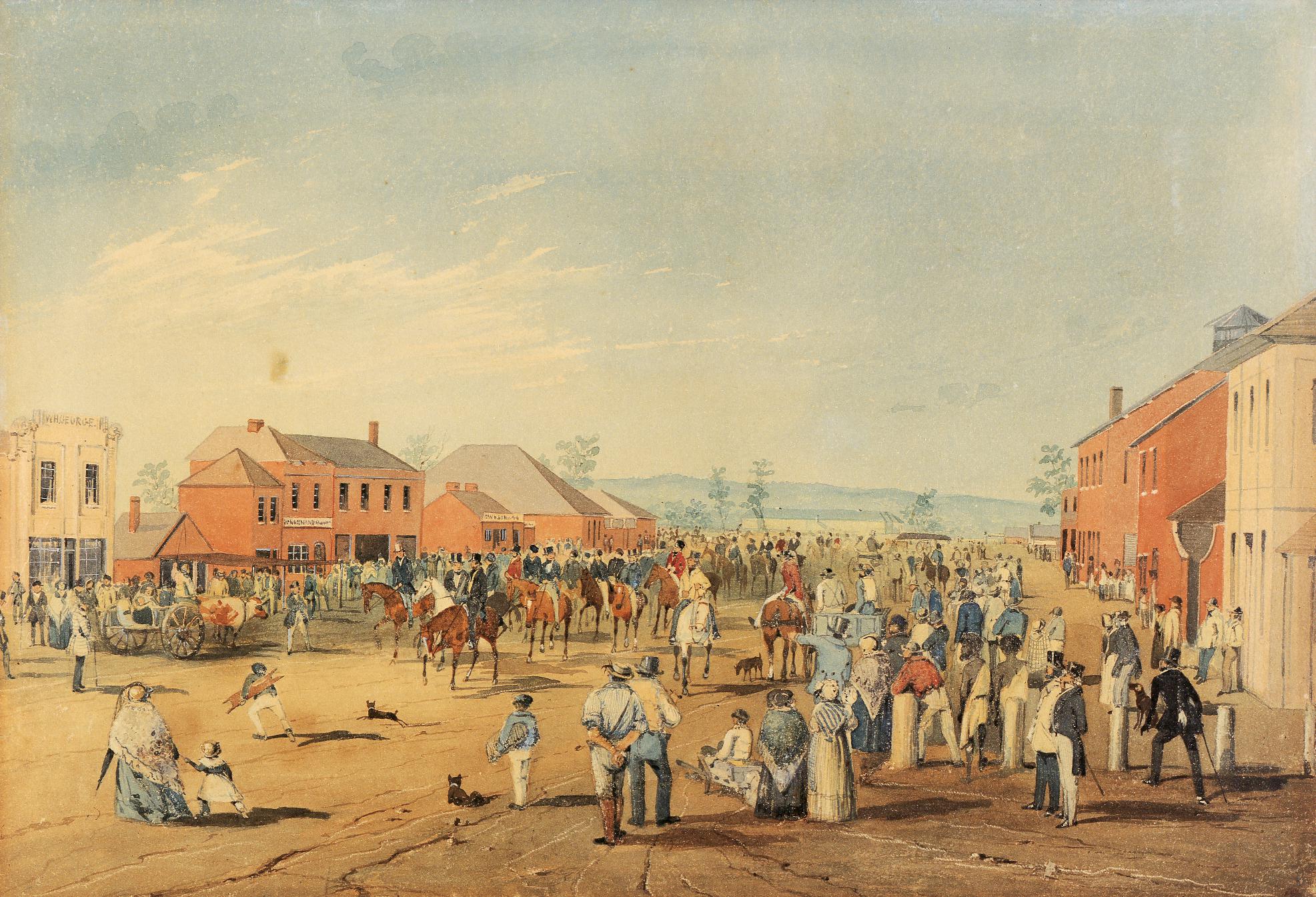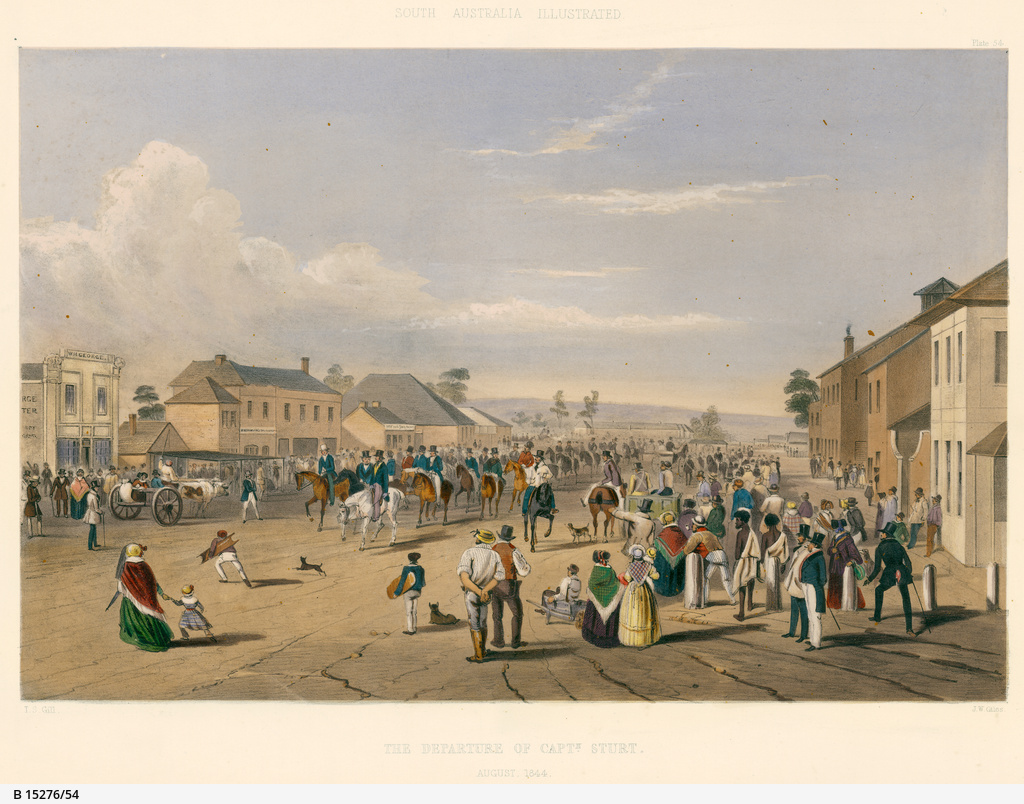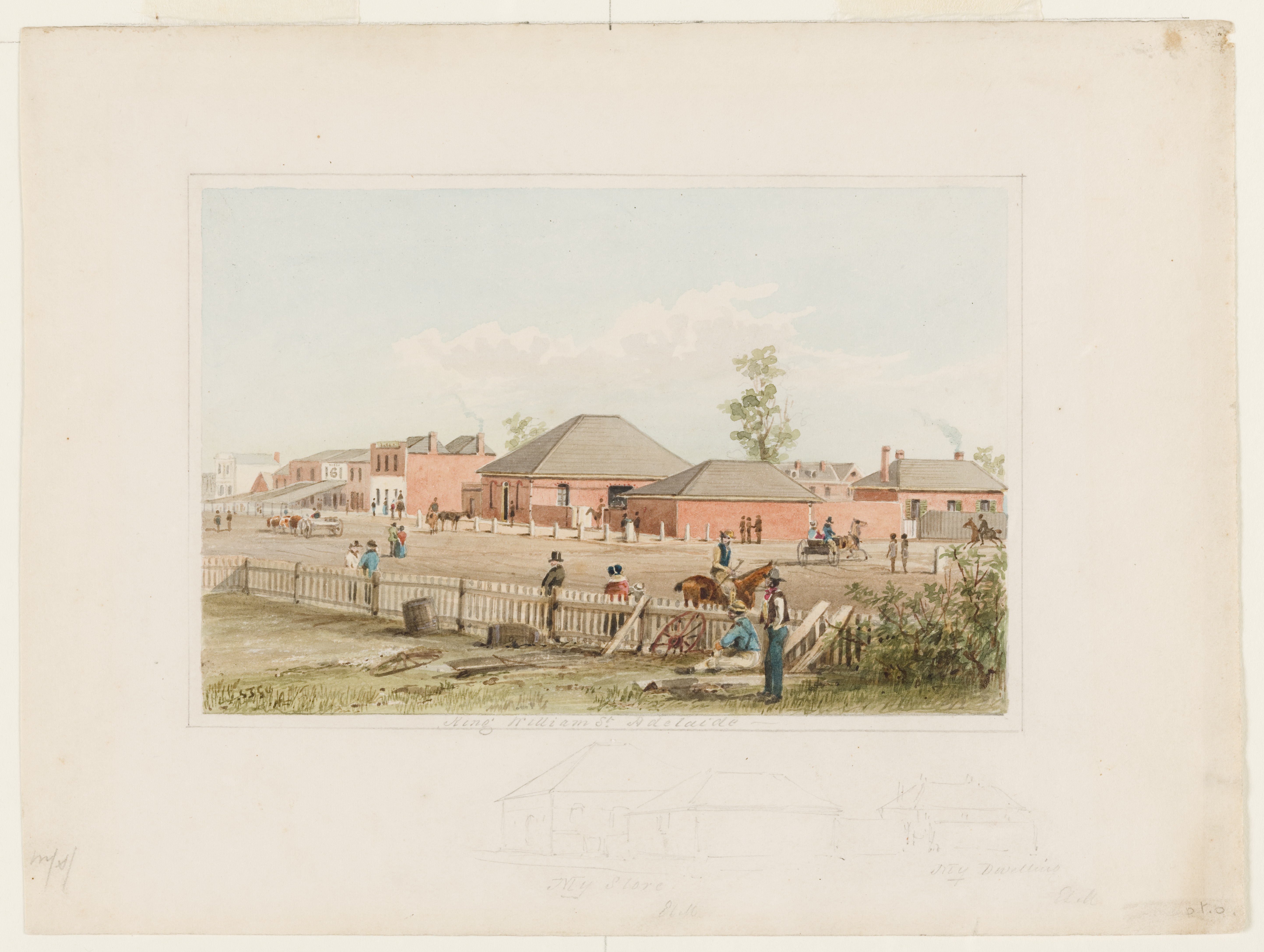 david coombe | history
david coombe | history
SUMMARY: S.T. Gill made several images representing the departure from Adelaide of Charles Sturt's Great Northern Expedition on 10 August 1844. Gill executed two distinct view points one city block apart. This article shows Gill in this case was not so much an on-the-spot documenter (dashing between viewpoints) as a purposeful artist creating unique works for his several clients. Some figures in the scenes are identified. I hypothesise E.L. Montefiore as the client for what is probably Gill's most recognised Adelaide painting, the large panorama of Sturt's departure held by the Art Gallery of South Australia (AGSA).
Article type: ANALYSIS
In this article ...
S.T. Gill made several images representing the departure from Adelaide of Charles Sturt's Great Northern Expedition on 10 August 1844.
Charles Sturt's Great Northern Expedition departed Adelaide (in a formal sense) on 10 August 1844. The occasion was a grand one. A public holiday was declared and an enormous public breakfast was held in Stocks' warehouse in Grenfell Street. The Southern Australian reported:
After breakfast, a procession of upwards of 100 horsemen, with a number of vehicles, was formed. Major O'Halloran, Captain Sturt, and his Honor the Judge, led the way, followed by the procession of colonists. They passed along King William Street to the City Bridge, through North Adelaide, and along the North Road as far as the Dry Creek.1
It was the largest turnout of colonists in South Australia's history.
The Register commented on the road conditions:
So much for the breakfast. In King William-street the well-loaded drays were ranged in order, one carrying a large boat. In a few minutes Captain Sturt appeared, accompanied by his Honour the Judge and Major O'Halloran. Troops of horsemen poured in on all sides, and the procession left town by the City Bridge at a walking pace. Having passed North Adelaide, Mr Frederic Dutton (who chiefly arranged the whole) gave the signal for a canter. The day was fine, but the roads wet and muddy. Many a coat was well spangled, and many a face but little better for its morning wash. Halting–it was amusing to see folks with their faces half-daubed already, daubing them entirely in their vain attempts to remove the mud, and asking their neighbours–"Is it cleaner now?"2
Gill is the only artist known to have portrayed the event. None of his images have mud-spattered colonists.
Gill painted two distinct views of this event: one of the head of the procession and others side-on to the cavalcade.
Gill's views are from two distinct vantage points.
The head-on view clearly shows the three named gentlemen: Major O'Halloran, Captain Sturt and Judge Cooper. Sturt is wearing top hat and tails and riding his well-known grey horse. The trio are seemingly included in the side-on view but are only barely visible in the distance.
The unique head-on watercolour can be understood in a way other than as a Sturt's Departure image. It is actually one of four views from Adelaide's main intersection to the cardinal points of the compass that Gill painted for James Allen. (See: S.T. Gill and James Allen, 1845.)
This view is south along King William Street from the intersection with Hindley Street. The other cardinal views are north, east and west from this intersection. Instead of Gill populating the street with general city activity, as he did for the other three, he filled this with a special occasion. In so doing this one watercolour served two purposes.
This analysis is supported by two anachronisms. First is the large red double storey building (fourth from left) of dentist surgeon Robert Norman. It was built between April and July 1845.3 Second is (at right) William Younghusband's store – with its octagonal turret – which was built in early 1845 and completed around March.4
Clearly this was not Gill "on the spot" capturing an event in August 1844, with its bespattering mud. Rather this shows Gill implementing Allen's goal to portray Adelaide as a modern progressing city. Gill would have first sketched this view, as well as the others from this intersection, to satisfy Allen's requirements. Filling this scene with Sturt's Departure may have been an afterthought.
Interestingly Allen's commission includes both views of Sturt's Departure, this head-on (a watercolour) as well as a side-on (a wash drawing). We don't know which came first, in fact they may have been contemporaneous, but we can be quite confident the head-on view was especially desired by Allen for the impression it would make "at home".
The side-on view is from a vantage point on Acre 140's vacant block diagonally across to Acre 108. There are five works taking this view: four of them show the cavalcade for Sturt's Departure and another is a plain street view without the special occasion.
This plain street scene was for E.L. Montefiore. The main subject is Montefiore's store and dwelling and Montefiore himself proudly annotated these in pencil below the main image.
Why did Gill choose this view for several pictures of Sturt's Departure? It was clearly a good visual and historical frame on which to place the entire cavalcade front and back. But what is the story in this picture? It's not really all about Charles Sturt who can only perhaps just be discerned at the head of the procession (distant left). So if these views are not about Sturt, what are they about? The focus is always Montefiore's store.
Figures in these scenes might also help us better understand the side-on cavalcade images. Two show a pair of gentlemen on a buggy – I think they are probably Governor George Grey and his private secretary Captain O'Halloran. Governor Grey was prominent at the breakfast but didn't lead the cavalcade. In these images the pair seem disconnected from the cavalcade to which all other eyes are directed. Three images have what appears to be a mounted marshall – perhaps one of the designated marshalls "Chas. J. F. Campbell, F. H. Dutton, and Jos. Johnson"5 – Dutton being reported as having the main role.
Figures in the pictures hint about client and purpose. We can summarise the main pictures:
| View | Reference | Client | Noted Figures | |
|---|---|---|---|---|
| Head-on | AGSA 0.644 | James Allen | Charles Sturt, Gill's "observer", James Allen | |
| Side-on | NLA R113 | James Allen | mounted marshall, Gill's "observer" | |
| Side-on | NGA 2012.1307 | George French Angas | Governor George Grey, mounted marshall, Gill's "observer" | |
| Side-on | AGSA 0.1128 | E.L. Montefiore (possibly) | Governor George Grey, Gill's "observer" | |
| Side-on | AGSA 0.1522 | preliminary for E L M? | mounted marshall, Gill's "observer" | |
| Side-on | SLNSW-M SSV*/Sp Coll/Gill/2 | E.L. Montefiore | Not Sturt's departure. Montefiore's store |
(The "observer" is a figural device Gill uses to take in the scene. In the side-on views the observer stands on the vacant block.)
Grey's inclusion makes good sense for Gill's pictures for George French Angas, Grey having given Angas much support during his stay.
The provenance for the grand panorama (AGSA 0.1128) is in South Australia and only known back to V.K. Burmeister in 1939. (See Appendix below.) Who might have been the original client? This was Gill's largest painting to date; it was a grand work for a client with deep pockets.
All the above-mentioned pictures likely predate Charles Sturt's return in January 1846, and we know Sturt's took his (Horrocks and other) pictures back to England with him, so he seems less likely to be the client.
Could it have been for Grey? If so, how did it leave the possession of Grey or Government House? Besides, although the image may feature Grey, it's not necessarily how he would've wanted to be portrayed – speeding in the wrong direction! The panorama may even have been painted for any one of the twenty-one gentlemen on the organising committee for Sturt's public breakfast.
Perhaps the strongest prospect as original owner was E.L. Montefiore whose business and dwelling were featured. In January 1844 Montefiore shifted business from Hindley Street to new premises in King William Street. "Mr Montefiore has also just finished a large, good store in King William-street, and a dwelling-house on the same acre, in Grenfell-street."6
Montefiore as client is just a hypothesis but it makes sense of the view which gave his new buildings prominence. He, if the client, would've got not just a picture of Sturt's departure (he too was a member of the breakfast committee) but also of his own new buildings and of the Governor. We do know Montefiore retained the humbler annotated watercolour sketch showing his buildings (without the cavalcade). He became insolvent in 1852 and perhaps he sold the grand panorama then.
You can scroll down to see all pictures along with detailed notes or jump to the List of Works.
The panorama AGSA 0.1128 was offered to the Gallery in 1939 by Verdi Killicoat Burmeister (1891–1956)
as an "Early Adelaide Street Scene" for the sum of 45 guineas. Louis McCubbin, the Director of the National Gallery, wrote to the Fine Arts Committee (10 October 1939) that "without doubt, it is the finest painting by Gill I have ever seen and, in addition to its artistic qualities, possesses great historic value. I strongly recommend its purchase, the price asked is high for a painting by this artist but, I doubt if the owner will take very much less for it. Perhaps an offer of 35 Gns. might be worth while." After some negotiation, the gallery bought it for 42 pounds. The title was changed to "Sturt's Overland Expedition leaving Adelaide, 10th August, 1844".7
V.K. Burmeister's grandfather H.W. Burmeister arrived in 1848, this providing a plausible route from Montefiore. V.K. Burmeister's uncle, Frederick Francis Burmeister (1858-1929) was himself an artist and had a large personal collection.8 However this is all speculation.
A year after the panorama was purchased, a smaller version appeared.
We had an enthusiastic half-hour the other morning when I showed Mr. McCubbin and Mr. Pitt a smaller Gill watercolor of the same scene, recently acquired by Mr. Mark Ridgway, one of Adelaide's keenest art connoisseurs and collectors. Mr. McCubbin immediately pronounced it as the original sketch for the larger picture. On the back of the sketch was a reference to a farewell to Captain Sturt's expedition in 1844. A boat on a waggon then satisfied Mr. Pitt.9
This "smaller version" seems to have made an appearance four decades earlier in 1899.
We have been shown a most interesting watercolour drawing by the early colonial artist, Mr. S. T. Gill, of Captain Sturt's departure from Adelaide upon his exploration expedition in 1844. It is in Gill's characteristic style, and represents a scene of bustle and enthusiasm in King William-street as it then was ... There are the inevitable horseman on the white steed which the artist almost invariably introduced into his street scenes ... It is said that the sketch, which is in capital preservation, was found behind a painting in the same frame, hence its good condition. It is the property of Miss Little, of Woodville, and ought to be added to our national collection of examples of early colonial art, which are becoming more and more valuable year by year.10
The prominent "horseman on the white steed" points to this being AGSA 0.1522 which came into the gallery's collection in 1953.11
For more background and analysis, see S.T. Gill - Scott Fakes and Adelaide Signatures.
You can scroll down to see all pictures along with detailed notes or click a link to jump to a specific work from the list.
Sturt's Expedition | National Library of Australia R113
Artist: Gill, S.T. | Date: 1845-05~/1845-06~ | Appleyard cat. 80.2 | 11.8(H) x 18(W) cm
Catalogue: S.T. Gill and James Allen, 1845
The scene is the departure from Adelaide of Charles Sturt's Great Northern Expedition on 10 August 1844 ("side-on" view).
The cavalcade is proceeding from Grenfell Street at the right of picture and turning into and continuing north along King William Street. The view is northeast, looking from a vacant block (acre 140) diagonally across the intersection to Montefiore's store (acre 108), behind and to the right of which are the South Australian Company buldings on Rundle Street (acre 44).
This is the narrowest of Gill's versions of this view and seems to exclude Montefiore's house.
Unlike AGSA 0.644, this scene predates King William Street premises (acre 79) of surgeon dentist Robert Norman built between April and July 1845.
For more detail see the catalogue / main entry.
Map | S. T. Gill - Adelaide
251
Sturt's overland expedition leaving Adelaide 1844 | National Gallery of Australia 2012.1307
Artist: Gill, S.T. | Date: 1845-02~/1845-06~ | Appleyard cat. 80.3 | 24.8(H) x 38.4(W) cm
Catalogue: S.T. Gill and George French Angas, 1844-1845
The scene is the departure from Adelaide of Charles Sturt's Great Northern Expedition on 10 August 1844 ("side-on" view).
The cavalcade is proceeding from Grenfell Street at the right of picture and turning into and continuing north along King William Street. The view is northeast, looking from a vacant block (acre 140) diagonally across the intersection to Montefiore's store (acre 108), behind and to the right of which are the South Australian Company buldings on Rundle Street (acre 44).The building at right is Montefiore's house. (Noticably absent from this picture are Gill's street dogs.)
This "side-on" view differs from the "head-on" view of AGSA 0.644 and predates the King William Street premises (acre 79) of surgeon dentist Robert Norman built between April and July 1845.
This painting has excellent provenance from the family of George French Angas. It is very likely that Gill painted this for Angas who went on to show it in his April 1846 London exhibition as "144. Starting of Captain Sturt from Adelaide, on his Expedition into the Interior, in August 1844". Angas departed Adelaide for Sydney and London on 2 July 1845. I think this painting was painted after Angas' 22 January 1845 return to Adelaide and before completion of Norman's.
There are two top-hatted gentlemen in a two wheeled vehicle, with the near man in the grey coat probably being Governor George Grey. That being the case, the other man could be Captain O'Halloran, Grey's Private Secretary. These gentlemen also appear in AGSA 0.1128.
There are two chickens and a rooster – a device frequently used by Gill. See Klemzig, Angas, a German Hay Wagon and Chickens.
For more detail see the catalogue / main entry.
Map | S. T. Gill - Adelaide
252
 Sturt's Overland Expedition leaving Adelaide, August 10th, 1844 | Art Gallery of South Australia 0.1522
Sturt's Overland Expedition leaving Adelaide, August 10th, 1844 | Art Gallery of South Australia 0.1522
Artist: Gill, S.T. | Date: 1845-02~/1845-04~ | Appleyard cat. 80.1 | 21.3(H) x 33.9(W) cm
Catalogue: S.T. Gill and E.L. Montefiore
The scene is the departure from Adelaide of Charles Sturt's Great Northern Expedition on 10 August 1844 ("side-on" view).
The cavalcade is proceeding from Grenfell Street at the right of picture and turning into and continuing north along King William Street. The view is northeast, looking from a vacant block (acre 140) diagonally across the intersection to Montefiore's store (acre 108), behind and to the right of which are the South Australian Company buldings on Rundle Street (acre 44).The building at right is Montefiore's house.
Building signs in this picture are Day & Son and (W.H.) George.
Compared with AGSA 0.1128, this picture has the same colouring, but omits Governor Grey and is half the size. It may be a study for the panorama (AGSA 0.1128) as was thought the case by gallery director Louis McCubbin in 1940.
For more detail see the catalogue / main entry.
250
 Sturt's Overland Expedition leaving Adelaide, August 10th, 1844 | Art Gallery of South Australia 0.1128
Sturt's Overland Expedition leaving Adelaide, August 10th, 1844 | Art Gallery of South Australia 0.1128
Artist: Gill, S.T. | Date: 1845-02~/1845-04~ | Appleyard cat. 80 | 41.3(H) x 72(W) cm
Catalogue: S.T. Gill and E.L. Montefiore
The scene is the departure from Adelaide of Charles Sturt's Great Northern Expedition on 10 August 1844 ("side-on" view).
The cavalcade is proceeding from Grenfell Street at the right of picture and turning into and continuing north along King William Street. The view is northeast, looking from a vacant block (acre 140) diagonally across the intersection to Montefiore's store and dwelling (acre 108), behind and to the right of which are the South Australian Company buldings on Rundle Street (acre 44). Montefiore's buildings were completed in January 1844.
There are several versions of this view by Gill. This is the most panoramic and further includes at far right the (back of) the Wesleyan Chapel in Gawler Place (acre 106).
There are two top-hatted gentlemen in a two wheeled vehicle, with the near man in the grey coat probably being Governor George Grey. That being the case, the other man could be Captain O'Halloran, Grey's Private Secretary. These gentlemen also appear in NGA 2012.1307.
Unlike AGSA 0.644, this scene predates the King William Street premises (acre 79) of surgeon dentist Robert Norman built between April and July 1845. This work is dated in relation to NGA 2012.1307.
Gill misspelled when he signed this "STG ADELADE".
For more detail see the catalogue / main entry.
Map | S. T. Gill - Adelaide
19
 Sturt's Overland Expedition leaving Adelaide, August 10th, 1844 | Art Gallery of South Australia 0.644
Sturt's Overland Expedition leaving Adelaide, August 10th, 1844 | Art Gallery of South Australia 0.644
Artist: Gill, S.T. | Date: 1845-06~/1845-11 | Appleyard cat. 81 | 27.2(H) x 40(W) cm
Catalogue: S.T. Gill and James Allen, 1845
The scene is the departure from Adelaide of Charles Sturt's Great Northern Expedition on 10 August 1844 ("head-on" view).
Charles Sturt and other dignitaries are at the head of the procession, with Sturt wearing top hat and tails and riding his well-known grey horse. The newspaper reported Major O'Halloran, Captain Sturt and Judge Cooper led. The view is south along King William Street from the intersection with Hindley Street (right foreground) and Rundle Street (out of picture) and includes street frontages in Adelaide acres 78 (right) and 79 and 108 (left).
The large red double storey building (signed, fourth from left) belonged to dentist surgeon Robert Norman and was built between April and July 1845. Also a building (right) shows William Younghusband's stores with its octagonal turret (completed around March 1845). Both buildings are anachronisms for Sturt's departure. So this was not Gill painting "on the spot" in August 1844.
Other buildings are from left: W.H. George plumber and glazier (white stone front), possibly C. Hussey, Robert Norman surgeon dentist, vacant land, Day and Sons blacksmiths, Montefiore merchant. Buildings at right likely include W. Richards tailor (opposite W.H. George).
This painting was used by George French Angas for plate 54 in his "South Australia Illustrated" and attributed to T.S. Gill. Although the painting could have been painted just in time for Angas' departure from Adelaide on 2 July 1845, there is strong provenance and other evidence for this being part of James Allen's commission. Allen left Adelaide for England in November 1845 and the painting was probably executed between July and November 1845. This implies Angas borrowed it from Allen or the South Australian Company when preparing the final installment of "South Australia Illustrated".
This picture is part of the James Allen commission. I think the character at left in the checked jacket, appearing in several pictures of the Allen commission, is likely James Allen.
For more detail see the catalogue / main entry.
Map | S. T. Gill - Adelaide
248
 The departure of Captain Sturt on his expedition into the interior | State Library of South Australia B 15276/54
The departure of Captain Sturt on his expedition into the interior | State Library of South Australia B 15276/54
Artist: Gill, S.T. (after) | Date: 1847-01~/1847-06~ | Appleyard cat. 81.1
Catalogue: George French Angas in London and S.T. Gill
The scene is the departure from Adelaide of Charles Sturt's Great Northern Expedition on 10 August 1844 ("head-on" view).
It is Plate 54 in Angas's "South Australia Illustrated". See also in book context with letterpress: https://digital.collections.slsa.sa.gov.au/nodes/view/2598#idx133515.
Angas attributes this picture to T.S. Gill. The original Gill watercolour (AGSA 0.644) was in the South Australian Company collection (No.10) and was from James Allen's commission. The conclusion is that Angas in London borrowed the original from either James Allen or the SA Company.
249
 King William street, Adelaide, ca. 1845 / possibly by S.T Gill or E.L. Montefiore | Mitchell Library, State Library of New South Wales SSV*/Sp Coll/Gill/2
King William street, Adelaide, ca. 1845 / possibly by S.T Gill or E.L. Montefiore | Mitchell Library, State Library of New South Wales SSV*/Sp Coll/Gill/2
Artist: Gill, S.T. | Date: 1845-07~/1846-03~ | Appleyard cat. n/a | 10.2(H) x 17.6(W) cm
Catalogue: S.T. Gill and E.L. Montefiore
This is a northeast view from Adelaide Acre 140 across to Acre 108 and Montefiore's buildings which were built between October 1843 and January 1844. Further along is Acre 79 and at far left W.H. George plumber and glazier (white stone front); Rundle Street frontage is only just glimpsed.
Below the picture are pencil notes on the buildings and the initials ELM (twice) - E L Montefiore. The featured buildings are Montefiore's, he pencilling below: "My Store" (centre pair) and "My Dwelling" (right).
This scene is a little later than the similar ones for Sturt's Departure. It includes Norman's premises (completed July 1845) and an extra Montefiore building right on the very corner. Also changed is the two storey building to the left of Montefiore's which is George Dehane the printer, whose second story was being erected in April 1845. Acre 140 is still vacant, being bought by Bank of Australasia in April 1846 with excavations beginning in June. The absence of the Waterhouse building which opened March 1846 (Acre 79) suggests that it may not yet have been built.
Thus a date is suggested between July 1845 and March 1846.
Gill's characteristic street dogs are missing from this street scene and the detail is not Gill's highest standard.
For more detail see the catalogue / main entry.
Map | S. T. Gill - Adelaide
217
David Coombe, original December 2021, updated 14 October 2025. | text copyright (except where indicated)
CITE THIS: David Coombe, 2021-2025, S.T. Gill – Subject – Sturt's Departure 1844, accessed dd mmm yyyy, <https://coombe.id.au/S_T_Gill/S_T_Gill_Subject_Sturt's_Departure_1844.htm>